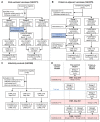This is a preprint.
Impact of a blood-stage vaccine on Plasmodium vivax malaria
- PMID: 35664997
- PMCID: PMC9164524
- DOI: 10.1101/2022.05.27.22275375
Impact of a blood-stage vaccine on Plasmodium vivax malaria
Update in
-
Vaccination with Plasmodium vivax Duffy-binding protein inhibits parasite growth during controlled human malaria infection.Sci Transl Med. 2023 Jul 12;15(704):eadf1782. doi: 10.1126/scitranslmed.adf1782. Epub 2023 Jul 12. Sci Transl Med. 2023. PMID: 37437014 Free PMC article.
Abstract
Background: There are no licensed vaccines against Plasmodium vivax , the most common cause of malaria outside of Africa.
Methods: We conducted two Phase I/IIa clinical trials to assess the safety, immunogenicity and efficacy of two vaccines targeting region II of P. vivax Duffy-binding protein (PvDBPII). Recombinant viral vaccines (using ChAd63 and MVA vectors) were administered at 0, 2 months or in a delayed dosing regimen (0, 17, 19 months), whilst a protein/adjuvant formulation (PvDBPII/Matrix-M™) was administered monthly (0, 1, 2 months) or in a delayed dosing regimen (0, 1, 14 months). Delayed regimens were due to trial halts during the COVID-19 pandemic. Volunteers underwent heterologous controlled human malaria infection (CHMI) with blood-stage P. vivax parasites at 2-4 weeks following their last vaccination, alongside unvaccinated controls. Efficacy was assessed by comparison of parasite multiplication rate (PMR) in blood post-CHMI, modelled from parasitemia measured by quantitative polymerase-chain-reaction (qPCR).
Results: Thirty-two volunteers were enrolled and vaccinated (n=16 for each vaccine). No safety concerns were identified. PvDBPII/Matrix-M™, given in the delayed dosing regimen, elicited the highest antibody responses and reduced the mean PMR following CHMI by 51% (range 36-66%; n=6) compared to unvaccinated controls (n=13). No other vaccine or regimen impacted parasite growth. In vivo growth inhibition of blood-stage P. vivax correlated with functional antibody readouts of vaccine immunogenicity.
Conclusions: Vaccination of malaria-naïve adults with a delayed booster regimen of PvDBPII/ Matrix-M™ significantly reduces the growth of blood-stage P. vivax . Funded by the European Commission and Wellcome Trust; VAC069, VAC071 and VAC079 ClinicalTrials.gov numbers NCT03797989 , NCT04009096 and NCT04201431 .
Conflict of interest statement
Declarations of Interest
SJD is an inventor on patent applications relating to adenovirus-based vaccines.
AMM has an immediate family member who is an inventor on patents relating to adenovirus-based vaccines.
CEC is an inventor on patents that relate to binding domains of erythrocyte-binding proteins of
Plasmodium parasites including PvDBP.JMR is an employee of Novavax, developer of the Matrix-M™ adjuvant.
All other authors have declared that no conflict of interest exists.
Figures





References
-
- Organisation WH. World Malaria Report2021.
-
- Miller LH, Mason SJ, Clyde DF, McGinniss MH. The resistance factor to Plasmodium vivax in blacks. The Duffy-blood-group genotype, FyFy. N Engl J Med 1976;295:302–4. - PubMed
Publication types
Associated data
Grants and funding
LinkOut - more resources
Full Text Sources
Medical
Miscellaneous
